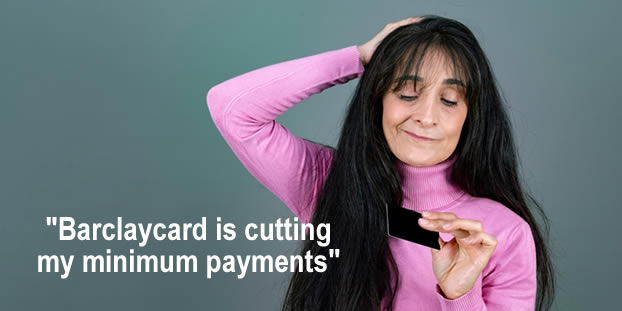 In April 2024, Barclaycard has told many customers that it will be setting lower minimum payments on their accounts from July.
In April 2024, Barclaycard has told many customers that it will be setting lower minimum payments on their accounts from July.
From a poll I ran on Instagram, Barclaycard has informed about 90% of cardholders. It looks as though this change is going to be across the board, affecting everyone. The messages are going out by email, letter or text. Look out for the communication if you haven’t yet heard.
The history to this change is that Barclaycard increased credit card minimum payments in January 2021.
Minimum payments slashed to just 1%
Barclaycard has three ways of setting the minimum monthly payment. It chooses the largest of:
- a percentage of the balance (this applies if you have a 0% balance transfer);
- a percentage of the balance plus the amount of interest being charged (this is the normal rate if you have a balance you are paying interest on); and
- £5 (this applies if you have a small balance).
The percentage amounts in (1) and (2) are being cut. For most people, the previous percentages were 3.75% of the balance or 2.5% of the balance plus the interest.
The changes I have seen are reducing these to 1% of the balance or 1% of the balance plus the interest.
This may sound like good news…
Barclaycard says “we are making the changes to give you greater flexibility each month”.
Flexibility is one of the big advantages of credit cards – you can pay more in a good month and less in a difficult month, unlike a loan. If you only pay the minimum amounts occasionally, then this is very useful,
It is true that by reducing the minimum payments, Barclaycard is increasing this flexibility.
But millions of people only make the minimum payments on their credit cards, often setting up a direct debit to pay this amount each month. This can result in very long times to clear a balance. And cutting the minimums will prolong the time people are in debt and increase the interest they pay.
You will pay a LOT more interest if you only pay the new lower minimums
Take a balance of £5,000 on a Barclaycard at 24% interest, where you only make the minimum payments and don’t spend on the card.
Under the old “2.5% of the balance plus the interest charged” rule, it would take just over 14 years to clear the card balance. And you would pay about £3,500 in interest.
14 years probably sounds too long. But with the new “1% of the balance plus the interest charged” calculation, it will take more than 30 years to clear the balance. And you would pay £8,500 in interest.
That sounds bad … is it even legal?
Yes it is legal – 1% plus interest is the bare minimum a credit card lender can charge, see the FCA’s rule CONC 6.7.5.
But at this level of minimum payment, a customer who pays the minimum for 18 months is going to start getting “persistent credit card debt” letters from Barclaycard. And Barclaycard will have to take action to help them after 3 years of paying the minimums.
Up until now, Barclaycard’s old minimum payment rules meant that few customers would come under the persistent credit card debt rules. But now it is possible that a lot may by the end of 2025.
How to avoid this extra interest
Barclaycard suggests that if you don’t like the change, you can reject it and stay on the old rules by closing the card.
That will only work if you are happy not to use the card again… and if you are there, there is a much better way!
You can simply set up a fixed direct debit amount in the app that is equal to your current minimum payment. By fixing the payment like this, the balance will be cleared in a lot fewer years and you will pay less interest then making the old minimum payments. Which is probably why Barclaycard didn’t suggest it as an option!
If you are still spending on the card, you can also do this, but you have to be careful if your balance has gone up a lot in case your fixed amount is less than the required minimum and you need to pay more. Check your statements each month. This isn’t ideal but it will work.
You will also clear a lot less of a 0% balance transfer
Barclaycard is offering 28 months 0% balance transfers. A great way to clear debt much more cheaply.
But many people just pay the minimum, happy that at least all their payment is clearing debt, not paying interest.
Under the old minimum rule of 3.75% of the balance, at the end of 28 months paying only the minimum, you would have cleared nearly two-thirds of the amount transferred.
Under the new minimum payment of just 1%, you will have cleared less than a quarter. If you can’t manage to get another 0% transfer, you may then be in difficulty when interest is added.
To avoid this problem, you should set up a direct debit for monthly amount that is as large as you can afford. You can do this in the app. Ideally you would take the amount you transfer and divide it by 28 (or the number of months you get, if that is less) and then pay that amount each month. But fixing any amount will help – and the larger the better.
Has Barclaycard been clear in its communications?
I don’t think it has.
Barclaycard says in the information about minimum payment calculations changing that “Paying more than the minimum can help you save interest“.
But it hasn’t been explicit that because it is reducing the minimums, this means that you will be paying more interest if you pay the minimums. It showed how much your minimum payments might drop, but didn’t mention how much longer it would take to repay the debt at this lower rate.
I have asked several people if Barclaycard warned them that the changes would cost more in interest. They all said variations on “no mention of it costing more.”
And even if someone did realise they would pay more, the change in percentages sounds small. I don’t think many would expect it to take twice as long to repay a balance, or cost more than twice as much, under the new rules.
A breach of the Consumer Duty?
Although Barclaycard is presenting the change as giving customers more flexibility, it is also a move that will generate a lot of extra profit for Barclaycard.
I don’t think most customers reading the information from Barclaycard will realise the full effect of what sounds like a minor change. I think Barclaycard should have known this and been clearer in its communications.
Also it isn’t clear that decreasing the minimum payments is contributing to what the regulator calls “a good customer journey”. Moving from a situation where Barclaycard had few or no customers in persistent credit card debt to one where many may fall into this by the end of 2025 seems like a retrograde step.
A lot of people when presented with the facts about the lower minimums, might want to remain on the old calculations if they could.
But Barclaycard has not provided any simple way for a customer to routinely make higher minimum payments if they want to, except by closing the card. It is possible to set a fixed payment amount to be collected by direct debit in the app, but that doesn’t work well if the card is being used for spending.
More articles:

Options when cards are maxed out

Card & catalogue affordability complaints

Is the interest rate on your card going up?